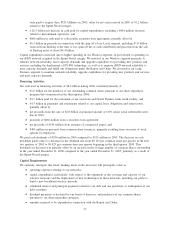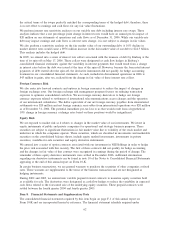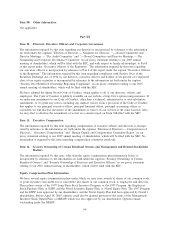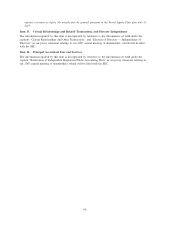Sprint - Nextel 2006 Annual Report Download - page 64
Download and view the complete annual report
Please find page 64 of the 2006 Sprint - Nextel annual report below. You can navigate through the pages in the report by either clicking on the pages listed below, or by using the keyword search tool below to find specific information within the annual report.the critical terms of the swaps perfectly matched the corresponding terms of the hedged debt; therefore, there
is no net effect to earnings and cash flows for any fair value fluctuations.
We perform interest rate sensitivity analyses on our variable rate debt including interest rate swaps. These
analyses indicate that a one percentage point change in interest rates would have an annual pre-tax impact of
$20 million on our statements of operations and cash flows as of December 31, 2006. While our variable-rate
debt may impact earnings and cash flows as interest rates change, it is not subject to changes in fair values.
We also perform a sensitivity analysis on the fair market value of our outstanding debt. A 10% decline in
market interest rates would cause a $976 million increase in the fair market value of our debt to $24.3 billion.
This analysis includes the hedged debt.
In 2005, we entered into a series of interest rate collars associated with the issuance of debt by Embarq at the
time of its spin-off on May 17, 2006. These collars were designated as cash flow hedges in Embarq’s
consolidated financial statements against the variability in interest payments that would result from a change
in interest rates before the debt was issued at the time of the spin-off. However, because the forecasted interest
payments of debt started after the spin-off, the derivative instruments did not qualify for hedge accounting
treatment in our consolidated financial statements. As such, included in discontinued operations in 2006 is
$43 million in gains, after tax, realized from the change in fair value of these interest rate collars.
Foreign Currency Risk
We also enter into forward contracts and options in foreign currencies to reduce the impact of changes in
foreign exchange rates. Our foreign exchange risk management program focuses on reducing transaction
exposure to optimize consolidated cash flow. We use foreign currency derivatives to hedge our foreign
currency exposure related to settlement of international telecommunications access charges and the operation
of our international subsidiaries. The dollar equivalent of our net foreign currency payables from international
settlements was $20 million and net foreign currency receivables from international operations was $20 million
as of December 31, 2006. The potential immediate pre-tax loss to us that would result from a hypothetical
10% change in foreign currency exchange rates based on these positions would be insignificant.
Equity Risk
We are exposed to market risk as it relates to changes in the market value of our investments. We invest in
equity instruments of public and private companies for operational and strategic business purposes. These
securities are subject to significant fluctuations in fair market value due to volatility of the stock market and
industries in which the companies operate. These securities, which are classified in investments and marketable
securities on the consolidated balance sheets, include equity method investments, investments in private
securities, available-for-sale securities and equity derivative instruments.
We entered into a series of option contracts associated with our investment in NII Holdings in order to hedge
the price risk associated with this security. The first of these contracts did not qualify for hedge accounting
and the changes in fair value of that contract were recognized in earnings during the period of change. The
remainder of these equity derivative instruments were settled in December 2006. Additional information
regarding our derivative instruments can be found in note 10 of the Notes to Consolidated Financial Statements
appearing at the end of this annual report on Form 10-K.
In certain business transactions, we are granted warrants to purchase the securities of other companies at fixed
rates. These warrants are supplemental to the terms of the business transaction and are not designated as
hedging instruments.
During 2002 and 2003, we entered into variable prepaid forward contracts to monetize equity securities held
as available for sale. The derivatives were designated as cash flow hedges to reduce the variability in expected
cash flows related to the forecasted sale of the underlying equity securities. These prepaid contracts were
settled between the fourth quarter 2004 and fourth quarter 2005.
Item 8. Financial Statements and Supplementary Data
The consolidated financial statements required by this item begin on page F-1 of this annual report on
Form 10-K and are incorporated herein by reference. The financial statement schedule required under
62
























